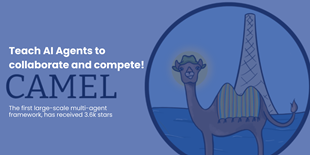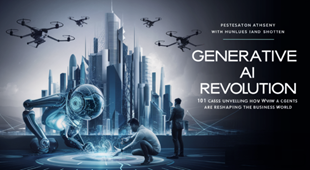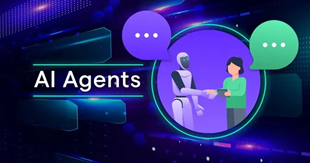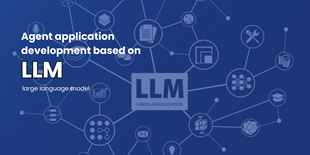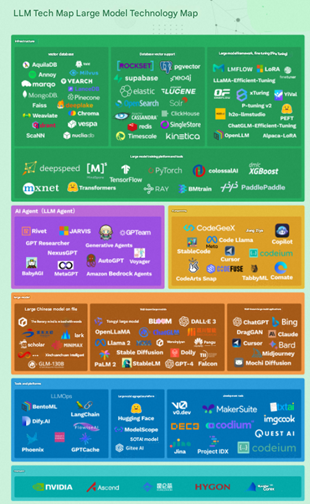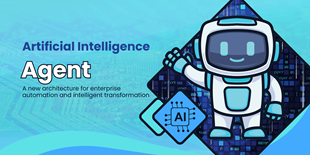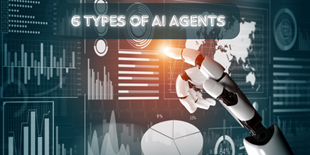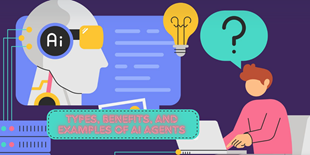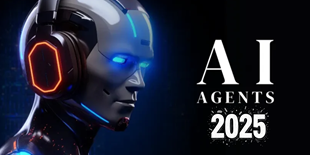Imagine that every decision in an enterprise can be based on in-depth data analysis, customer service can be personalized to each user's needs, and internal processes are automated to the point where human supervision is almost unnecessary. This is not a futuristic fantasy, but an enterprise revolution led by AI Agents , which is rapidly changing our business world.
At the Google Cloud Next 2024 conference, we witnessed 101 vivid examples of this change. AI agents are no longer just machines that answer questions, they have become experts in problem solving and are reshaping six key areas of business operations. This article will give you an in-depth understanding of how AI agents can improve efficiency, stimulate innovation, and bring unprecedented business value to enterprises in customer service, employee empowerment, creative ideation, data analysis, code creation, and network security.
Forget about those simple question-answering bots. The true potential of generative AI is being unlocked in the enterprise, where it is no longer just about predicting answers, but taking actions that will change the way companies operate. AI agents: no longer just answering questions, but solving them.
AI Agent: No longer just answering questions, but solving them
These cutting-edge agents are more than just passive responders. They are proactive problem solvers designed to achieve specific goals and deliver tangible business value. Think of an AI agent as a skilled employee who can seamlessly navigate the complexities of your business, streamlining processes and increasing efficiency like never before.
6 battlefields: AI Agent is reshaping enterprise operations
There are 6 key areas where AI agents are proving their worth:
1. Customer Service: Create a customer experience that exceeds expectations
AI-powered customer service agents are revolutionizing the customer journey. They can personalize interactions, provide instant support, and even anticipate customer needs, creating a seamless and satisfying experience. Imagine a world where customers can find the perfect product, resolve issues effortlessly, and feel truly valued at every touchpoint.
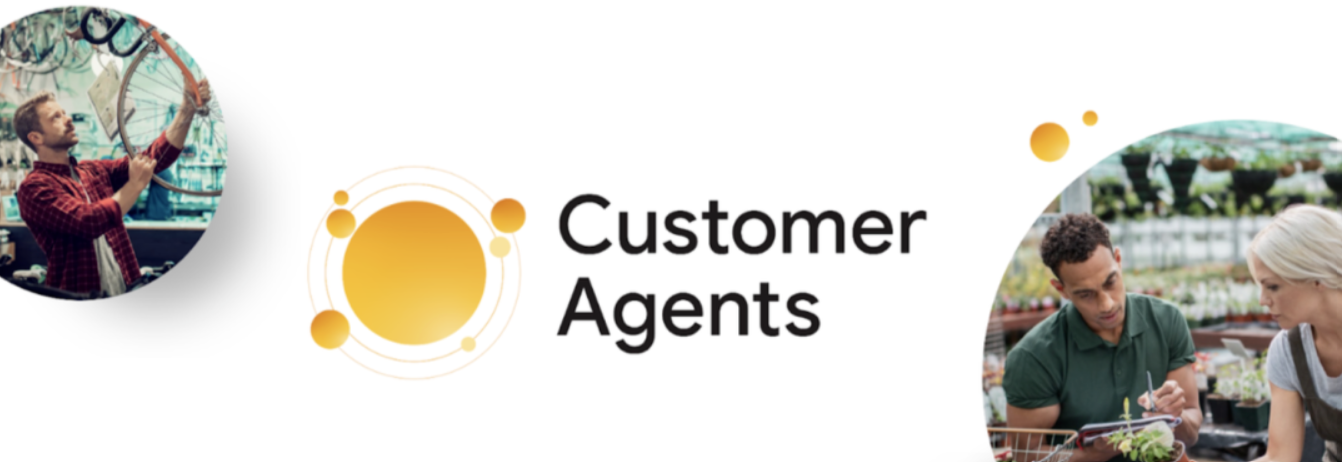
Here are some examples of using AI agents to improve customer service:
- ADT: Building a customer agent that helps millions of customers select, order, and set up home security systems.
- Alaska Airlines: Developing a personalized travel search experience, providing hyper-personalized recommendations, and cultivating customer loyalty through AI- generated content.
- Best Buy: Launched a generative AI -powered virtual assistant to answer product questions, reschedule order deliveries, manage Geek Squad subscriptions, and more.
- Central Texas Regional Mobility Authority: Modernizing transportation operations with AI for smoother, more efficient journeys.
- Etsy: Uses AI training to optimize search recommendations and advertising models, providing better listing suggestions to buyers and helping sellers grow their business.
- Golden State Warriors: Using AI to improve fan experience content in the Chase Center app.
- IHG Hotels & Resorts: Building a generative AI- powered chatbot to help guests easily plan their vacations directly in the IHG One Rewards mobile app.
- ING Bank: Developing a generative AI chatbot to enhance employee self-service capabilities and improve the quality of answers to customer queries.
- Magalu: Creating the “ brain of Lu” to provide Lu with an interactive conversational agent to enhance the customer service experience.
- Mercedes Benz: Infusing online storefronts with e-commerce capabilities through a generative AI- powered intelligent sales assistant and leveraging AI to personalize marketing campaigns.
- Oppo/OnePlus: Integrate AI models into mobile phones to provide innovative customer experiences such as news and audio recording summaries, AI toolboxes, etc.
- Samsung: Deploys AI models on Galaxy S24 smartphones to provide users with features such as text summarization, organization, and amazing image editing.
- Minnesota Division of Driver and Vehicle Services: Helps non-English speakers obtain driver licenses and other services through two-way, real-time translation.
- Pepperdine University: Using AI to provide real-time translated subtitles and notes for multilingual students and faculty.
- Sutherland: Combining human expertise with AI to elevate customer-facing teams by automatically surfacing suggested responses and automating insights in real time.
- Target: Using AI to power AI solutions on the Target app and Target.com , including personalized Target Circle offers and Starbucks at Drive Up.
- Tokopedia: Used AI to improve data quality and increased unique products sold by 5%.
- US News: After implementing AI search, key metrics such as click-through rate, page dwell time, and page traffic achieved double-digit growth.
- IntesaSanpaolo, Macquarie Bank and Scotiabank: Exploring the potential of generative AI to transform banking, particularly by improving productivity and operational efficiency.
2. Employee empowerment: Unleash employee potential and stimulate collaborative efficiency
Say goodbye to the days of tedious tasks and information overload. AI-powered employee agents are streamlining workflows, automating repetitive processes, and enabling employees to focus on high-value work. These agents can answer questions, provide insights, and even generate creative content, saving valuable time and increasing productivity.

Here are some examples of how companies are using AI agents to empower their employees:
- Avery Dennison: Empowering employees with generative AI to enable secure, flexible and borderless collaboration, increasing productivity to drive growth.
- Bank of New York Mellon: Build a virtual assistant to help employees find relevant information and answers to their questions.
- Bayer: Building a radiology platform to assist radiologists with data analysis, intelligent search, and creation of documentation that meets healthcare requirements required for regulatory approval, and using AI to more efficiently develop other digital health solutions and drugs.
- Bristol Myers Squibb: Using AI to transform the documentation process for its clinical trials, reducing the time it takes to complete a first draft of a document from weeks to minutes.
- BenchSci: Developing generative AI solutions that enable scientists to understand complex connections in biological research, saving time and financial resources and ultimately bringing new medicines to patients faster.
- Cintas: Developed an internal knowledge center for customer service and sales teams using AI search to easily find critical information.
- Covered California: Using AI to automate parts of the documentation and verification process to help improve the consumer and employee experience.
- Dasa: Helping doctors detect relevant findings in test results more quickly.
- DaVita: Using AI to transform kidney care, including analyzing medical records, discovering key patient insights, and reducing errors. AI enables physicians to focus on personalized care, significantly improving healthcare delivery.
- Discover Financial: Helping its 10,000 contact center representatives search and synthesize information from detailed policies and procedures during calls.
- HCA Healthcare: Is testing Cati, a virtual AI caregiver assistant that helps ensure continuity of care when one caregiver shift ends and another begins, and uses generative AI to improve workflows for time-consuming tasks, such as clinical documentation, so that doctors and nurses can focus more on patient care.
- The Home Depot: Built an app called Sidekick that helps store associates manage inventory and keep shelves stocked; notably, a visual model helps the assistant prioritize actions to take.
- Los Angeles Rams: Leveraging AI across the board, from content analysis to player scouting.
- McDonald's: Will leverage data, AI and edge technologies across its thousands of restaurants to implement innovations faster and enhance the employee and customer experience.
- Pennymac: AI is being used across multiple teams , including HR, where it is helping them accelerate recruiting, hiring, and onboarding of new employees.
- Robert Bosch: Revolutionizing marketing with generative AI- driven solutions that streamline processes, optimize resource allocation, and maximize efficiency across more than 100 dispersed departments.
- Symphony: Using AI to help finance and trading teams collaborate across multiple asset classes.
- Uber: is using AI agents to help employees improve productivity, save time and be more effective in their jobs, such as launching new tools that can summarize communications with users and even display the context of previous interactions so that front-line employees can provide more help and improve efficiency.
- U.S. Department of Veterans Affairs: Edge AI is being used to improve cancer detection for service members and veterans, such as augmented reality microscopes (ARMs) deployed at remote military treatment facilities around the world, helping pathologists detect cancer faster and more accurately.
- The United States Patent and Trademark Office: Improved the quality and efficiency of its patent and trademark examination processes by implementing AI-driven technologies.
- Verizon: is using generative AI to help network operations and customer experience teams get the answers they need faster.
- Victoria's Secret: Is testing an AI-powered agent to help its in-store assistants find information about product availability, inventory, and fit and size tips so they can better tailor recommendations to customers.
- Vodafone: Using AI to search for and understand specific commercial terms and conditions in more than 10,000 contracts with more than 800 communications operators .
- WellSky: is integrating healthcare and AI capabilities to reduce the time spent completing documents outside of business hours.
- Woolworths: Empowering employees with confidence in communication through AI . It also uses AI to create next-generation promotions, as well as quickly assist customer service representatives in summarizing all previous customer interactions in real time.
- Box, Typeface, Glean, CitiBank, and Securiti AI: discussed developing AI-driven applications across the enterprise and achieving measurable ROI in marketing, financial services, and HR use cases.
- Highmark Health and Freenome: Exploring how AI can improve efficiency and innovation in care delivery, drug discovery, clinical trial planning, and bringing drugs to market.
3. Creative conception and production: unlimited creativity and accelerated production
Creativity knows no boundaries with AI-powered creative agents that can generate stunning visuals, craft engaging narratives, and even compose original music, allowing anyone to become a designer, artist, or storyteller.

Here are some examples of how companies are leveraging AI agents to spark creativity and accelerate content creation:
- Belk ECommerce: Using generative AI to craft better product descriptions, a necessary but time-consuming task for digital retailers.
- Canva: Uses AI to power its video creation tool, helping users skip tedious editing steps as they create shareable and engaging videos in seconds.
- Carrefour: Used AI to deploy Carrefour Marketing Studio in just five weeks, an innovative solution that simplifies the creation of dynamic campaigns across various social networks, allowing marketers to build hyper-personalized campaigns with just a few clicks to deliver ads to customers that they care about.
- Major League Baseball: Continues to innovate its Statcast platform so teams, broadcasters and fans can gain live game insights.
- Paramount: AI is helping to streamline the process of creating basic metadata and video summaries that are used to showcase content and create personalized experiences for viewers.
- Procter & Gamble: Developed an internal generative AI platform using AI to accelerate the creation of photo-realistic imagery and creative assets, giving marketing teams more time to focus on advanced planning and deliver exceptional experiences for their consumers.
- WPP: Will integrate its Intelligent Marketing Operating System into generative AI capabilities, enabling its people and clients to deliver new levels of personalization, creativity, and efficiency. This includes using AI models to enhance the accuracy and speed of content performance predictions.
4. Data analysis: gain insights into data and drive smart decision-making
The era of data-driven decision making has arrived, and AI-driven data agents are leading the way. These agents can analyze massive data sets, discover hidden patterns, and generate actionable insights, enabling organizations to make smarter, faster, and more informed decisions.

Here are some examples of how organizations are using AI agents to unlock the power of data:
- AI21 Labs: Provides an AI integration called “Contextual Answers” that allows users to query data in a conversational way and get high-quality answers quickly.
- Anthropic: Offering its Claude 3 model family on the AI Platform , providing organizations with more model choices to achieve intelligence, speed, cost efficiency, and enterprise use case vision.
- The Minor Planet Institute: Using artificial intelligence to discover hidden asteroids in existing astronomical data.
- Contextual: is working with AI service providers to provide enterprises with fully customizable, trustworthy, privacy-focused AI built on internal knowledge bases.
- Cox 2M: Ability to make smarter, faster business decisions using AI-driven analytics.
- Essential AI: is using accelerator chips optimized for AI to train its own AI models.
- Generali Italia: Used AI to build a model evaluation pipeline to help machine learning teams quickly evaluate performance and deploy models.
- Globo: Is using AI to combat piracy by blocking pirated streams in real time during live events.
- Hugging Face: is working with AI service providers on open science, open source, cloud, and hardware to enable companies to build their own AI using the latest open models.
- Kakao Brain: Built a large-scale AI language model, the largest Korean-specific LLM on the market with 66 billion parameters. They also developed a text-to-image generator called Karlo .
- Mayo Clinic: Has provided thousands of its scientific researchers with access to 50 petabytes of clinical data through AI search , speeding up information retrieval in multiple languages.
- McLaren Racing: is using AI to gain last-millisecond insights during races and training to gain a competitive advantage.
- Mercado Libre: Is testing AI to optimize capacity planning and bookings with delivery companies and airlines to complete shipments faster.
- Mistral AI: Will use infrastructure optimized for artificial intelligence to further test, build, and expand its LLM.
- MSCI: Using machine learning combined with AI to enrich its data sets, helping clients gain insight into approximately 1 million asset positions to help manage climate-related risks.
- NewsCorp: is using AI to help search data across 30,000 sources and 2.5 billion news articles updated daily .
- Orange: operates in 26 countries where local data must be kept in each country. They are using AI to improve network performance and provide super responsive translation capabilities.
- Spotify: Using AI to generate machine learning podcast previews at scale, they plan to continue pushing the boundaries of data engineering and data science to build better experiences for their customers and creators.
- UPS: Is building a digital twin of its entire distribution network so that workers and customers alike can see where their packages are at any time.
- Workday: is using natural language processing to make data insights more accessible to both technical and non-technical users.
- Woven: is working with AI service providers to leverage massive data and AI to enable autonomous driving, powered by thousands of machine learning workloads on AI supercomputers, which results in a 50% savings in total cost of ownership to support autonomous driving.
- Broward County, Florida, and Southern California Edison: are using geospatial capabilities and AI to improve infrastructure planning and monitoring, generate new insights, and build regional resiliency for communities facing climate challenges today and in the future.
- Kinaxis and Dematic: are building data-driven supply chains to address logistics use cases including scenario modeling, planning, operations management and automation.
- NOAA and USAID: are among the U.S. government agencies using AI to unlock critical data insights, streamline operations, and improve mission outcomes, all with an emphasis on responsible AI.
5. Code creation: accelerate software development and optimize code quality
AI-powered code agents are revolutionizing the software development lifecycle. They can generate code, optimize algorithms, and even debug complex systems, enabling developers to build better software faster.

Here are some examples of how companies are using AI agents to improve software development efficiency and code quality:
- Capgemini: has been using AI to improve software engineering productivity, quality, security, and developer experience, with early results showing increased coding workload and more stable code quality.
- Commerzbank: Improving developer efficiency through AI’s powerful security and compliance capabilities.
- Quantiphi: During its AI pilot, developer productivity increased by more than 30% .
- Replit: Developers will access infrastructure, services, and underlying models through AI , while developers will access a collaborative code editing platform.
- Seattle Children's: The hospital is using AI to improve data engineering productivity and accelerate development.
- Turing: is customizing AI on its private codebase to empower its developers with highly personalized and contextual coding suggestions that increase productivity by approximately 30% and make everyday coding more enjoyable.
- Wayfair: After trialing AI, developers who used a code agent were able to set up their environments 55% faster than before, saw a 48% improvement in code performance during unit testing, and 60% of developers reported that they were able to focus on more satisfying work.
6. Network security: build a solid defense line to protect data security
In an increasingly complex threat landscape, AI-driven security agents are essential to protecting sensitive data and critical infrastructure. These agents can detect anomalies, respond to threats in real time, and even predict future attacks, enabling security teams to stay ahead and protect their organizations.
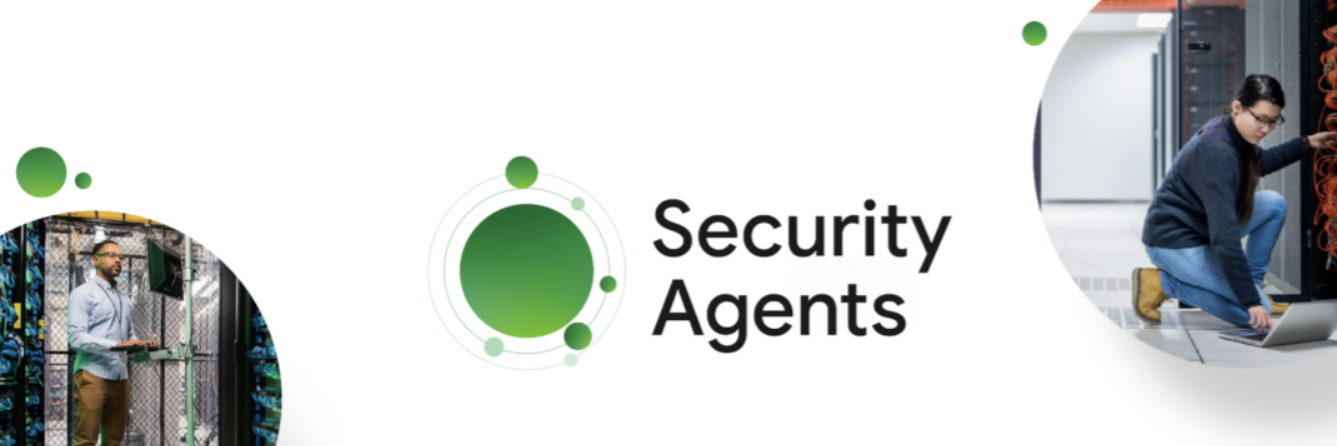
Here are some examples of how organizations are leveraging AI agents to enhance their cybersecurity defenses:
- BBVA: Using AI to detect, investigate and respond to security threats in an AI security platform that now displays critical security data in seconds, compared to minutes or hours previously, and provides highly automated responses.
- Behavox: is using AI technology and LLM to provide industry-leading regulatory compliance and front-office solutions to global financial institutions.
- Charles Schwab: has integrated its own intelligence into its artificial intelligence-driven AI security platform so that analysts can better prioritize their work and respond to threats.
- Fiserv: Our security operations engineers can create detections and playbooks more easily, and our analysts can get answers faster.
- Grupo Boticário: Adopting a real-time security model to prevent fraud and detect and respond to issues.
- Palo Alto Networks: Palo Alto Networks’ AI-driven security operations platform is built on more than a decade of expertise in machine learning models and the industry’s most comprehensive, rich, and diverse data store. Powered by advanced cloud infrastructure and advanced AI services, the combination provides global scale and near real-time protection across all network security products.
- Pfizer: It is now possible to aggregate cybersecurity data sources, reducing analysis time from days to seconds.
101 cases: AI Agent is changing the world
From global retailers to healthcare giants, organizations across industries are embracing AI agents to solve their most pressing challenges and unlock new possibilities. These 101 real-world examples showcase the power of AI agents in action, showing how they are transforming industries and creating a better future for businesses and individuals.
The key to these powerful agents lies in multimodal AI. No longer limited to text-based interactions, AI agents can now process and generate information in a variety of communication modes - text, voice, images, video, audio, and even code. This means that AI agents can understand and respond to us in more natural and intuitive ways, making them more effective collaborators and problem solvers.
As AI technology continues to advance, the capabilities of AI agents will only become more sophisticated and impactful. We can expect more innovative applications to emerge that push the boundaries of what’s possible and fundamentally change the way we live and work.
The future of AI agents is bright, and we have only begun to scratch the surface of their potential.
Article reference: https://cloud.google.com/transform/101-real-world-generative-ai-use-cases-from-industry-leaders
